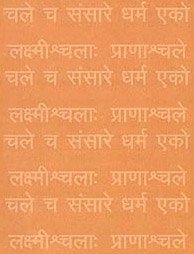Kshemapura, Kṣemapura: 2 definitions
Introduction:
Kshemapura means something in Hinduism, Sanskrit, the history of ancient India. If you want to know the exact meaning, history, etymology or English translation of this term then check out the descriptions on this page. Add your comment or reference to a book if you want to contribute to this summary article.
In Hinduism
Vedanta (school of philosophy)
Source: Google Books: History of the Dvaita School of Vedānta and Its Literature
The city of “Kṣemapura” with a flourishing and prosperous population

Vedanta (वेदान्त, vedānta) refers to a school of orthodox Hindu philosophy (astika), drawing its subject-matter from the Upanishads. There are a number of sub-schools of Vedanta, however all of them expound on the basic teaching of the ultimate reality (brahman) and liberation (moksha) of the individual soul (atman).
India history and geography
Source: Jainworld: Jain History (h)Kṣemapura (क्षेमपुर) is the historical name for Gerasoppe in North Kanara District, which was associated with Jainism, at least from 1378 A.D..

The history of India traces the identification of countries, villages, towns and other regions of India, as well as mythology, zoology, royal dynasties, rulers, tribes, local festivities and traditions and regional languages. Ancient India enjoyed religious freedom and encourages the path of Dharma, a concept common to Buddhism, Hinduism, and Jainism.
See also (Relevant definitions)
Full-text: Gerasoppe.
Relevant text
Search found 1 books and stories containing Kshemapura, Kṣemapura, Ksemapura; (plurals include: Kshemapuras, Kṣemapuras, Ksemapuras). You can also click to the full overview containing English textual excerpts. Below are direct links for the most relevant articles:
Trishashti Shalaka Purusha Caritra (by Helen M. Johnson)
Part 2: Former births of Rāvaṇa, Sītā, Lakṣmaṇa, Sugrīva, Bhāmaṇḍala, Lavaṇa and Aṅkuśa < [Chapter X - Rāma’s mokṣa (emancipation)]